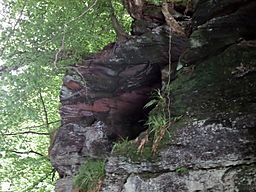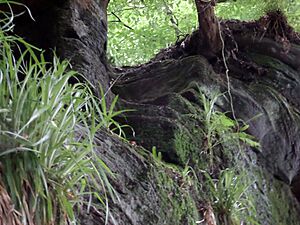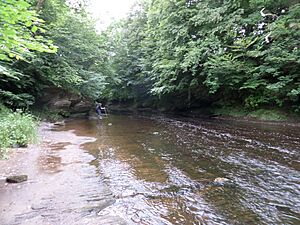Peden's Cave (Auchinbay) facts for kids
Quick facts for kids Peden's Cave (Auchinbay) |
|
|---|---|

The opening to Peden's Cave overlooking the River Lugar
|
|
| Location | Ochiltree, East Ayrshire |
| OS grid | NS 4880 2362 |
| Length | 8 feet (2.4 m) |
| Elevation | 10 feet (3.0 m) |
| Entrances | 1 |
| Difficulty | Caution required |
| Hazards | Access |
| Access | By carved steps |
Peden's Cave is a special cave in East Ayrshire, Scotland. It is found near the town of Ochiltree. The cave is partly natural and partly made by people. It sits high up on red sandstone rocks, looking over the River Lugar.
This cave is famous because people believe it was a hiding place for Covenanters. Covenanters were a group of Scottish Presbyterians in the 1600s. They wanted to practice their religion freely. One very well-known Covenanter minister, Alexander Peden, is said to have hidden here. This was especially true during a difficult time in the 1680s, known as the 'Killing Times'. During this time, Covenanters were often hunted down.
Exploring Peden's Cave
Peden's Cave is high up on a red sandstone cliff. The cave floor is about 10 feet (3.0 m) above the River Lugar. It is on the south-western side of the river. The cave is also close to an old road that went past Auchinbay Farm. This road led towards the Auchinleck Estate. The cave is hard to see from above, making it a good hiding spot. Another famous cave, Wallace's Cave, is a short distance upstream.
The cave itself is not very big. It is about 6 feet (1.8 m) high, 4 feet (1.2 m) wide, and 8 feet (2.4 m) long. You can see marks from tools inside. These marks show that people helped to make the cave bigger or shaped it from a smaller natural hole. There is a bench or shelf cut into the rock inside. Six steps are also cut into the rock face to help you get down to the cave. However, getting to the cave can still be a bit tricky.
The cave's opening is easy to spot from the other side of the Lugar Water. But it is hard to reach from there. It is thought that people might have used bushes, like gorse or willow, to cover the entrance. This would have helped to hide it. Next to the cave, there is a large flat area. Some people think this area was also shaped by humans. It might have been used to keep horses or store food.
The Cave's History
Alexander Peden was a Covenanter minister. He often preached outdoors at meetings called conventicles. Because he was on the run from the King's soldiers, he used many caves to hide. Other caves he used were near Barskimming and on Craigie Hill. He also hid near the Water of Girvan. His last hiding place might have been the Cleuch Glen in Sorn Parish. He supposedly asked for this cave to be made when he knew he was very ill. He even hid under straw when soldiers searched it.
The exact details are not fully clear. But one story says that Alexander Peden's brother lived at Tenshilling Farm. This farm was close to the estate's Deer Cave. Alexander's brother is said to have brought food to the cave. This food was for Alexander and other Covenanters who hid with him.
It might have been in this cave that Alexander Peden became very ill. He then moved closer to his brother's farm, where he passed away on January 26, 1686. He was secretly buried in the churchyard at Auchinleck. However, the King's soldiers later dug up his body. He was then buried at the bottom of the gallows tree in Cumnock. Today, a graveyard is there with memorials to Alexander Peden and other Covenanters. The soldiers had wanted to hang his body from the tree. But William, the second Earl of Dumfries, stopped them.
Many other caves in Ayrshire were also used by Covenanters for hiding. These include the Cleeves Cove near Dalry. Another is Dunton Cove near Waterside in East Ayrshire.
Peden's Cave is near an old crossing point over the River Lugar. This was before any bridges were built. It might seem strange for a hiding place to be so close to a busy spot. Also, important places like Dumfries House, Auchinleck House, and Ochiltree House were all nearby.
The cave might have been used for other things after the Covenanters' time. It could have been a shelter for travelers. Or it could have been a base for people helping others cross the river, especially when the water was high. Local fishermen have certainly found it to be a useful shelter.
Many other places are named after Peden. These include Peden's Pulpit near Failford and another near Dalry. There is also a Peden's Stone and Peden's Hut.
Images for kids








